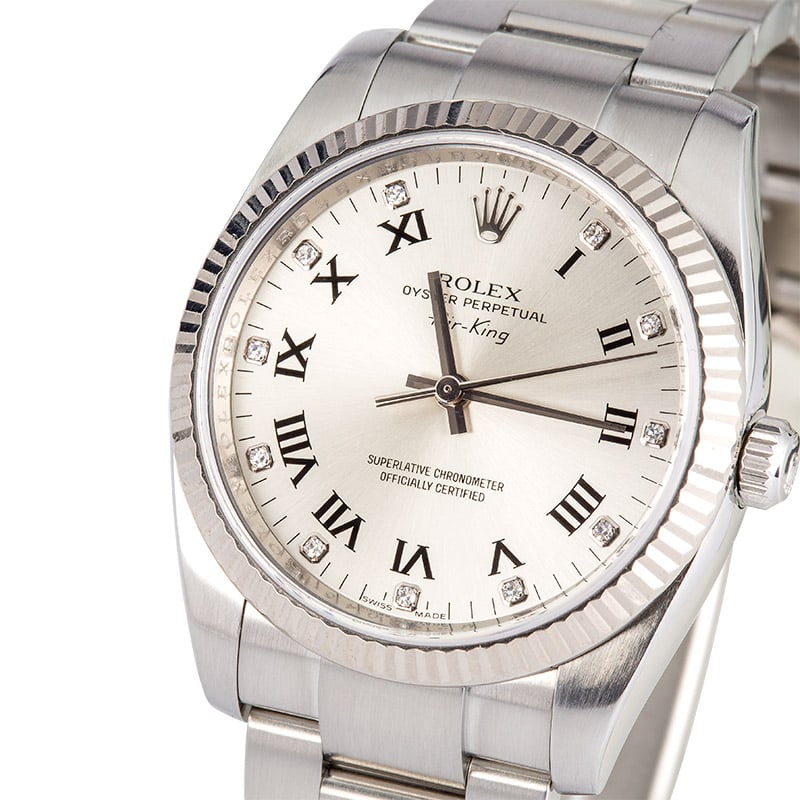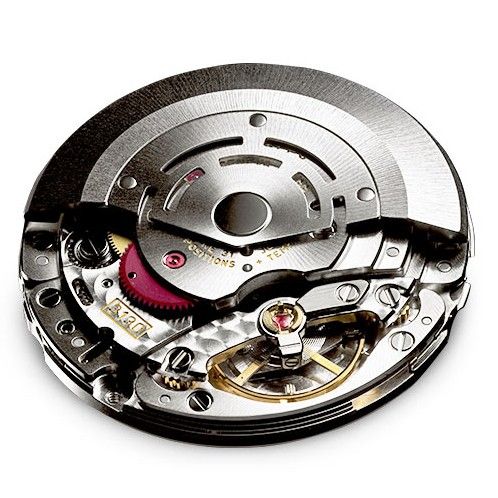Notes: The distinct design of the Rolex Air-King reference 114234 is sure to turn heads. The contemporary reference 114234 is utilizes Rolex's infamously waterproof 34mm Oyster case equipped with a scratch-resistant sapphire crystal, Twinlock screw-down crown, screw-down case back, and durable 904L stainless steel construction. White Rolesor, Rolex's signature combination of stainless steel and 18 karat white gold, elevates the style of this luxury timepiece, while offering durable construction that will withstand decades of wear and tear.
Mechanism: The 3130 is the sister movement to the 3135. The 3135 was introduced in 1988, but for some reason the 3130, although simpler due to the lack of a date function, was not introduced until 2001. The calibre 3130 is a self-winding mechanical movement entirely developed and manufactured by Rolex. Like all Rolex Perpetual movements, the 3130 is a certified Swiss chronometer, a designation reserved for high-precision watches that have successfully passed the Swiss Official Chronometer Testing Institute (COSC) tests. It is fitted with a Parachrom hairspring, offering greater resistance to shocks and to temperature variations. Its architecture, in common with all Oyster watch movements, makes it singularly reliable.
The 3130 is distinguished from the 3000 by several features; whilst it still beats at 28,000bph it now uses a balance bridge rather than a balance cock and also has a Breguet overcoil hairspring; this means that now all Rolex movements will feature these two company signatures. Also introduced on the 3130 are a new style of reversers for the automatic movement; these are much more efficient than the ones currently used and are an offshoot of the ones introduced 2 years ago on the 2235 lady’s movement. It can safely be assumed that the new reversers will gradually be introduced across the rest of the range, but it is rare that the “base” movement gets technological advances before the more “high end” variants.
Hacking: When moving the crown from position 3 (hand setting) to position 2 (manual winding), the second hand resumes operation before the crown actually 'clicks' into position 2. And if you release pressure before the crown clicks into position 2, but after the second hand resumes, the crown springs back out and the second hand hacks again. The pressure on the balance through the "stop seconds lever"/"balance stop spring" can be released and reapplied before the crown/stem moves into the indexed position. This happens if you hesitate while pushing/pulling the crown/stem into position allowing the balance to start and stop before the crown/stem locates. The hacking mechanism uses a thin, flat brass plate to put pressure on the balance wheel. When the pressure is removed the watch resumes ticking which apparently is not at the same time the crown clicks into position.
The 3130 is distinguished from the 3000 by several features; whilst it still beats at 28,000bph it now uses a balance bridge rather than a balance cock and also has a Breguet overcoil hairspring; this means that now all Rolex movements will feature these two company signatures. Also introduced on the 3130 are a new style of reversers for the automatic movement; these are much more efficient than the ones currently used and are an offshoot of the ones introduced 2 years ago on the 2235 lady’s movement. It can safely be assumed that the new reversers will gradually be introduced across the rest of the range, but it is rare that the “base” movement gets technological advances before the more “high end” variants.
Hacking: When moving the crown from position 3 (hand setting) to position 2 (manual winding), the second hand resumes operation before the crown actually 'clicks' into position 2. And if you release pressure before the crown clicks into position 2, but after the second hand resumes, the crown springs back out and the second hand hacks again. The pressure on the balance through the "stop seconds lever"/"balance stop spring" can be released and reapplied before the crown/stem moves into the indexed position. This happens if you hesitate while pushing/pulling the crown/stem into position allowing the balance to start and stop before the crown/stem locates. The hacking mechanism uses a thin, flat brass plate to put pressure on the balance wheel. When the pressure is removed the watch resumes ticking which apparently is not at the same time the crown clicks into position.
Family Notes: The Rolex Air-King history dates back to 1945. During this time, the Rolex Oyster Perpetual was becoming increasingly popular among combat pilots for its durable case and easy-to-read dial. Hans Wilsdorf appreciated the fact that many brave pilots opted for a Rolex timepiece and chose to honor their loyalty with the addition of the Rolex "Air Series", which also included the iconic Air-King




